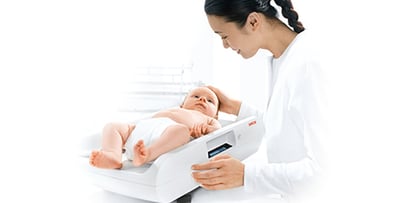We can all relate to having our weight taken during each medical visit. Our first encounter with a scale just after our birth is a kind of harbinger to what will be the most consistent measure of our health status done by clinicians.

Obtaining patient weight is fundamental, found across an array of hospital departments and specialties including:
- Emergency Room – Patients in cardiac distress are often taken directly in stretchers from ambulances to special large-platform scales located in ER’s that accommodate the stretcher. Patient weight is obtained for the calibration of dosage of emergency cardiac drugs, such as Adrenaline and Amiodarone.
- Labor and Delivery
- NICU (neonatal intensive care unit) – Some infants need additional in-patient care post-delivery. Weight is closely monitored down to the gram as a vital health indicator and for medications.
- Oncology – Weight is used in metabolic assessments such as determination of patient lean mass and fat mass, which are crucial to treatment and dosing.
- Internal Medicine
- Surgery Centers – Basic for administering anesthesia.
- Weight Loss/Wellness – There are more recent, growing trends of programs and facilities dedicated to medically-assisted, non-surgical weight loss programs. Also, there are bariatric surgery procedures with behavior modification and after-care visits for patients.
A Common Problem: Measurement Errors

Until recently in U.S. hospitals, patient weight has been manually recorded by nursing staff in imperial/lb values. This has led to issues causing transcription errors and miscalculations, as depicted in the following scenarios:
- Clinician transcription errors can occur when manually copying the weight value to another place due to making keyboard errors in the process, or misreading another’s handwriting. This leads to a downstream error in dosage calculations that include weight as a factor.
- Evidence shows hazards arise when a hospital has a common practice of recording weight in imperial values (lb), since medication calculations are very often done with metric/kg values. This can lead to miscalculations where patient weight is misrepresented, due to confusion of unit-of-measure (i.e. numbering system).
The mistaken use of a weight expressed in imperial units within a metric calculation can lead to drastic medication errors. Events have been reported and causes identified.
- “… patient’s weight had been measured in pounds but had been documented in the pharmacy system in kilograms. As a result, the patient had received approximately double the Dalteparin dose that was intended.”
Weight-Based Medication Dose Errors, Medication Incidents - Institute for Safe Medication Practices Canada
- “Triage nurse incorrectly entered the patient's weight (25 pounds) as a weight in kilograms in the electronic medical record (EMR).”
A Weighty Mistake - Agency for Healthcare Research and Quality
- “Organizations must strive for strategies that achieve the following… Establish processes for weighing and weight documentation … Use health information technology… Standardize where possible (e.g., obtain and document patient weight in metric units, set scales to default to metric).”
Medication Safety: Inaccurate Patient Weight Can Cause Dosing Errors - ECRI Institute
The above ECRI citation, in particular, points to the fast-moving trend in the adoption of hospital-wide metric unit standardization of weight scales. Medical scales typically have a switchable unit-of-measure feature that allows weight to be displayed in imperial or metric values, depending on what is selected by the scale user. However, this can also potentially lead to a misreading of the scale value if a clinician mistakes the value displayed by the scale.
Solutions to the Problem
- The use of metric-only scales in hospitals at the policy and compliance level.
- Patient scales are widely available as natively metric-only devices, or they can be programmatically locked by hospitals' biomedical departments to display metric-only values that can’t be altered by users. For many hospitals this is a first, practical step in the standardization of all patient scales across their facilities.
- Patient scales are widely available as natively metric-only devices, or they can be programmatically locked by hospitals' biomedical departments to display metric-only values that can’t be altered by users. For many hospitals this is a first, practical step in the standardization of all patient scales across their facilities.
- For a complete solution that also provides time-saving efficiencies to patient workflow, hospital organizations are turning to scales that seamlessly integrate with EMR systems.
- In this complete solution, patient weight and height are displayed in metric values, if desired, and sent automatically to the EMR. This automated connectivity between scale and EMR systems removes the concerns of transcription and dose-miscalculation errors; it is at the forefront of innovations in patient weighing and measuring.

A Market Leader Propels Innovation
The use of metric-only scales and innovative EMR connectivity solutions in hospitals are being powered by the industry’s leading brands.
seca – precision for health is the global leader in medical measuring systems and scales. They are the only medical scale solutions provider that offers both lbs/kg and kg-only EMR-certified (not simply EMR-ready) patient scales that seamlessly interoperate with an automated, bi-directional communication workflow.
seca is Cerner CareAware® VitalsLink validated and supports similar integration solutions with a wide range of EMR systems including Epic, Allscripts, Athenahealth, Philips and many others.
This innovative workflow of seca scales includes the important feature of bi-directional communication with the EMR, which displays a visual confirmation on the scale that the correct patient record in the EMR has received the measurement values (no assumptions have to be made by clinician). 
Though it may appear simple, this kind of device-EMR system interoperability and patient record verification is a cutting-edge patient scale feature, due to the technology required. It bodes well for the accurate capture and documentation of patient weight in healthcare settings where it is most crucial.
Weighing patients for all its simplicity has far-reaching implications. Other examples of how obtaining accurate weight is crucial to medication dosage and clinical decisions in hospitals include:
- Anesthetic agents – Weight provides a starting measure for the titrate-to-effect process of applying anesthesia.
- Nutrition status – When assessing cardiometabolic risk, one's nutrition status is also observed. In recent years many hospitals have launched medically-assisted weight loss and metabolic wellness programs in response to the obesity epidemic in the U.S.
- Tidal Volume - This is the amount of air displaced during a standard inhalation or exhalation during a normal breath without extra effort, measured by a device called a spirometer. When patients are mechanically ventilated, body weight is crucial for the ventilator’s tidal volume
- Anticoagulants - Blood thinning medications such as Warfarin are prescribed to reduce the risk of blood clots. The dosage is based on weight and other factors.
- Chemotherapeutic agents - In addition to total body weight, these agents can include related measures of total lean tissue and body surface area (BSA).
- Nuclear medicine – Weight is used for the determination of appropriate radiopharmaceutical doses.
- Opioids/Analgesics – Weight and age are used to determine the dosage of pain management medications.
About CME: CME Corp is the nation’s premier source for healthcare equipment, turnkey logistics, and biomedical services, representing 2 million+ products from more than 2,000 manufacturers.
With two corporate offices and 35+ service centers, our mission is to help healthcare facilities nationwide reduce the cost of the equipment they purchase, make their equipment specification, delivery, installation, and maintenance processes more efficient, and help them seamlessly launch, renovate and expand on schedule.
We are proud to work with seca, one of our strategic vendors, to help our end-user customers with this very important issue. For more information go to cmecorp.com or call 800-338-2372.


